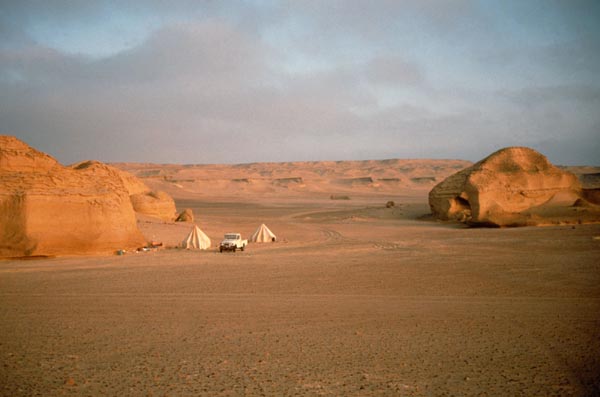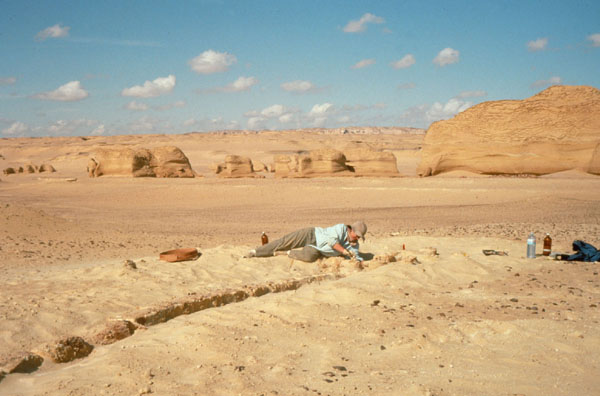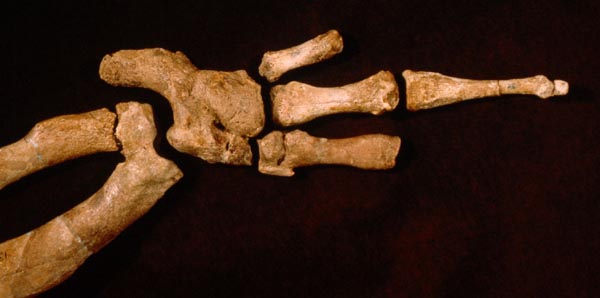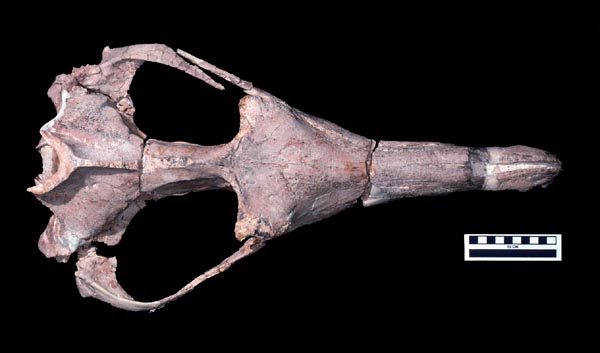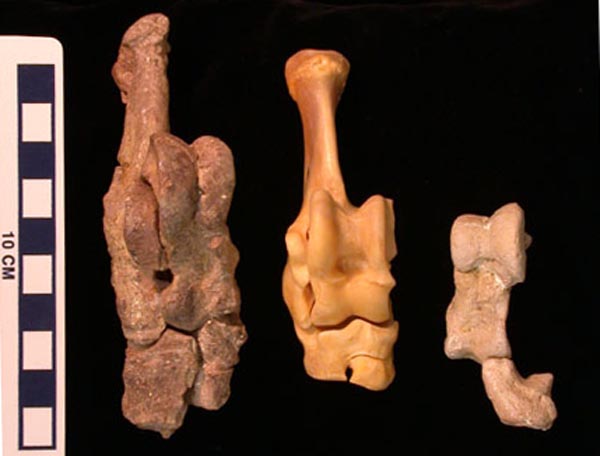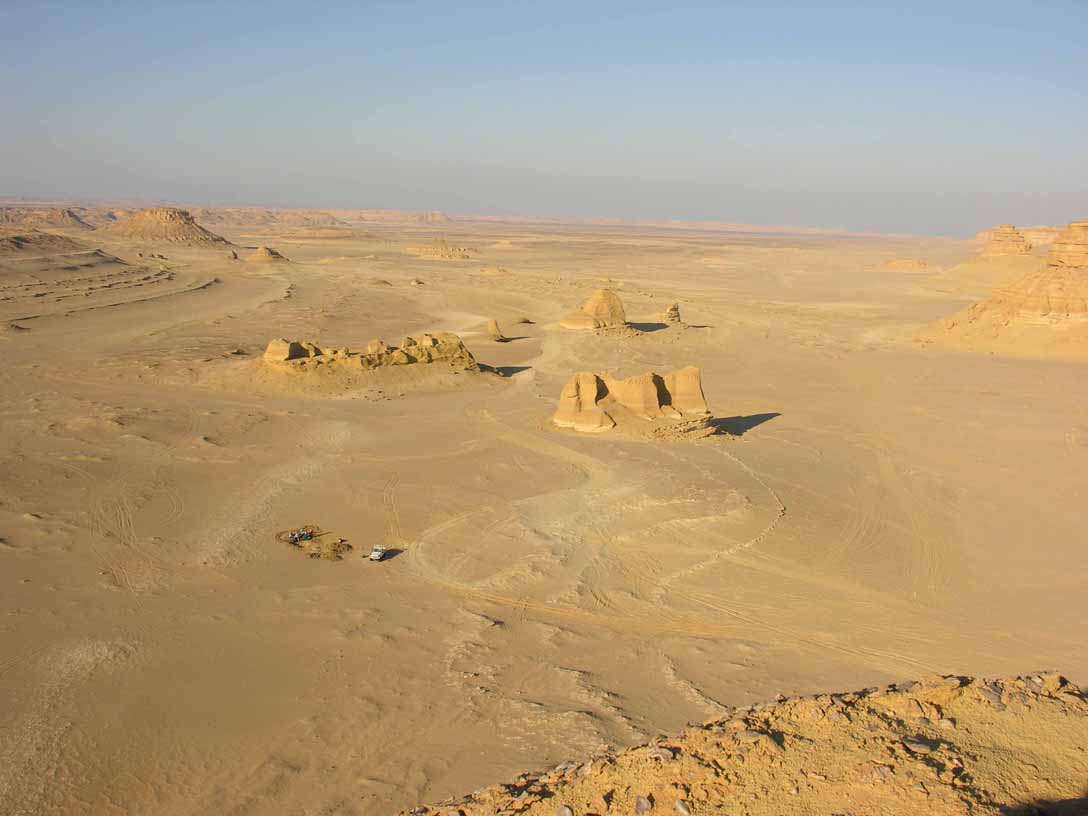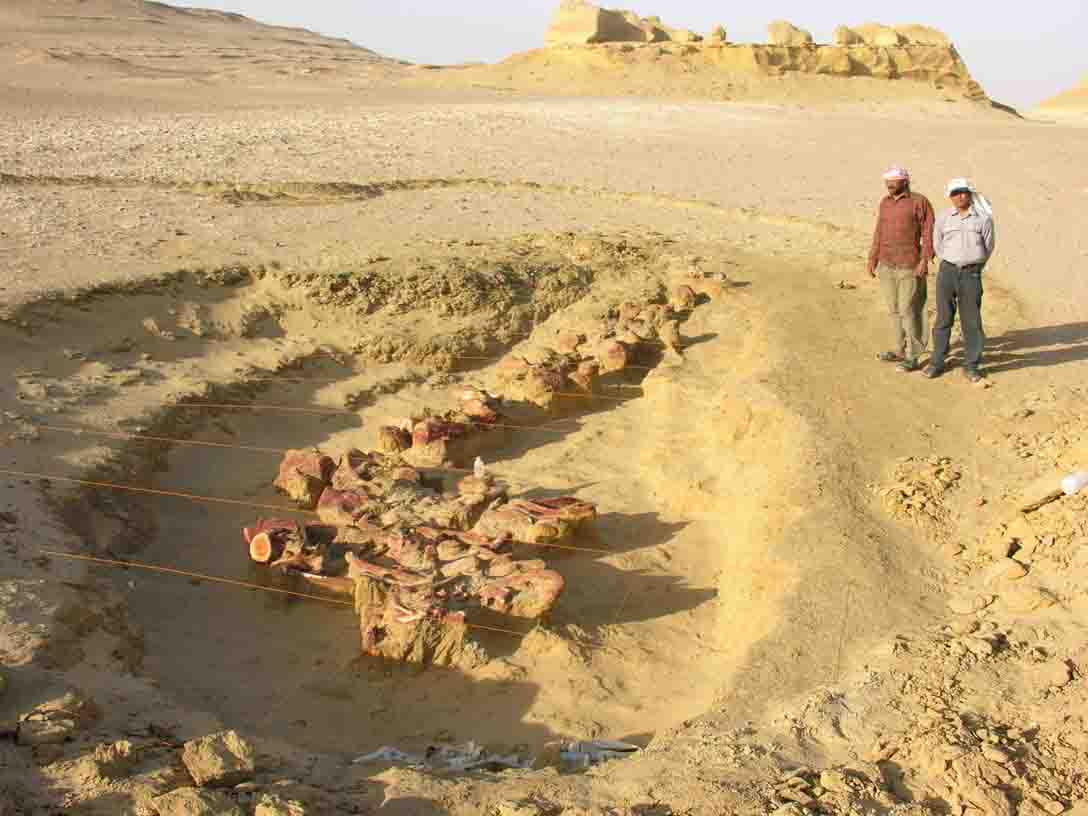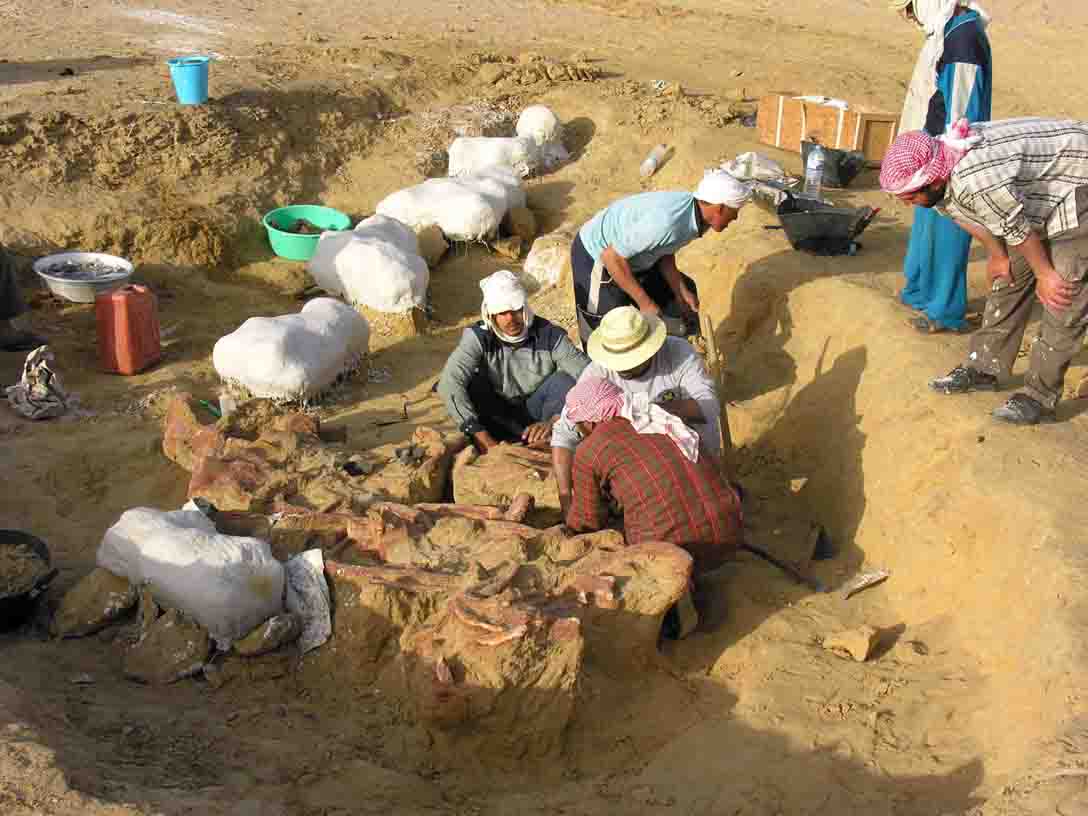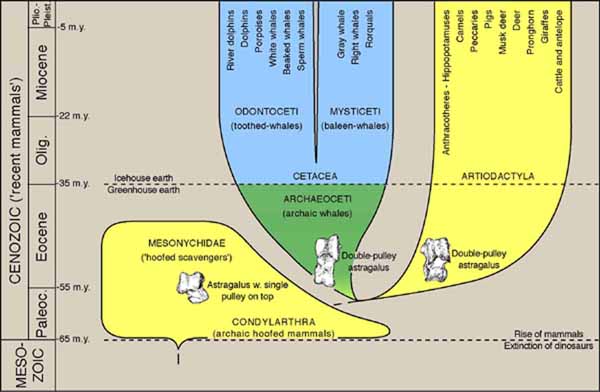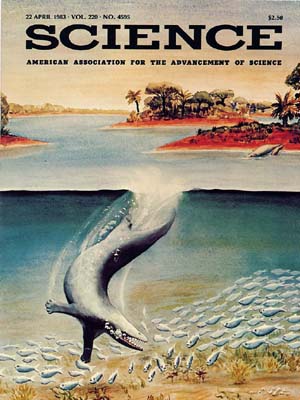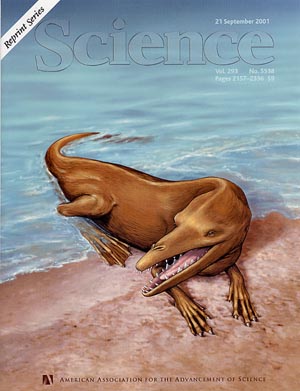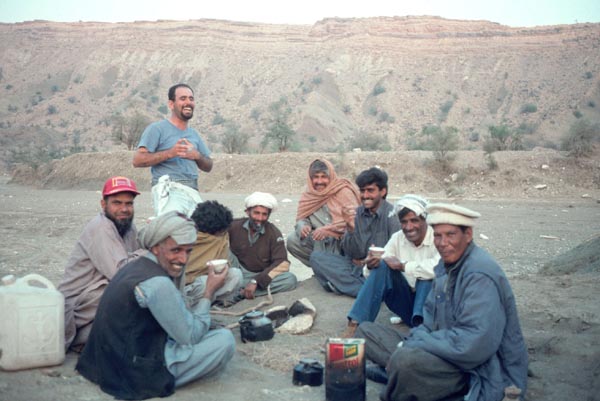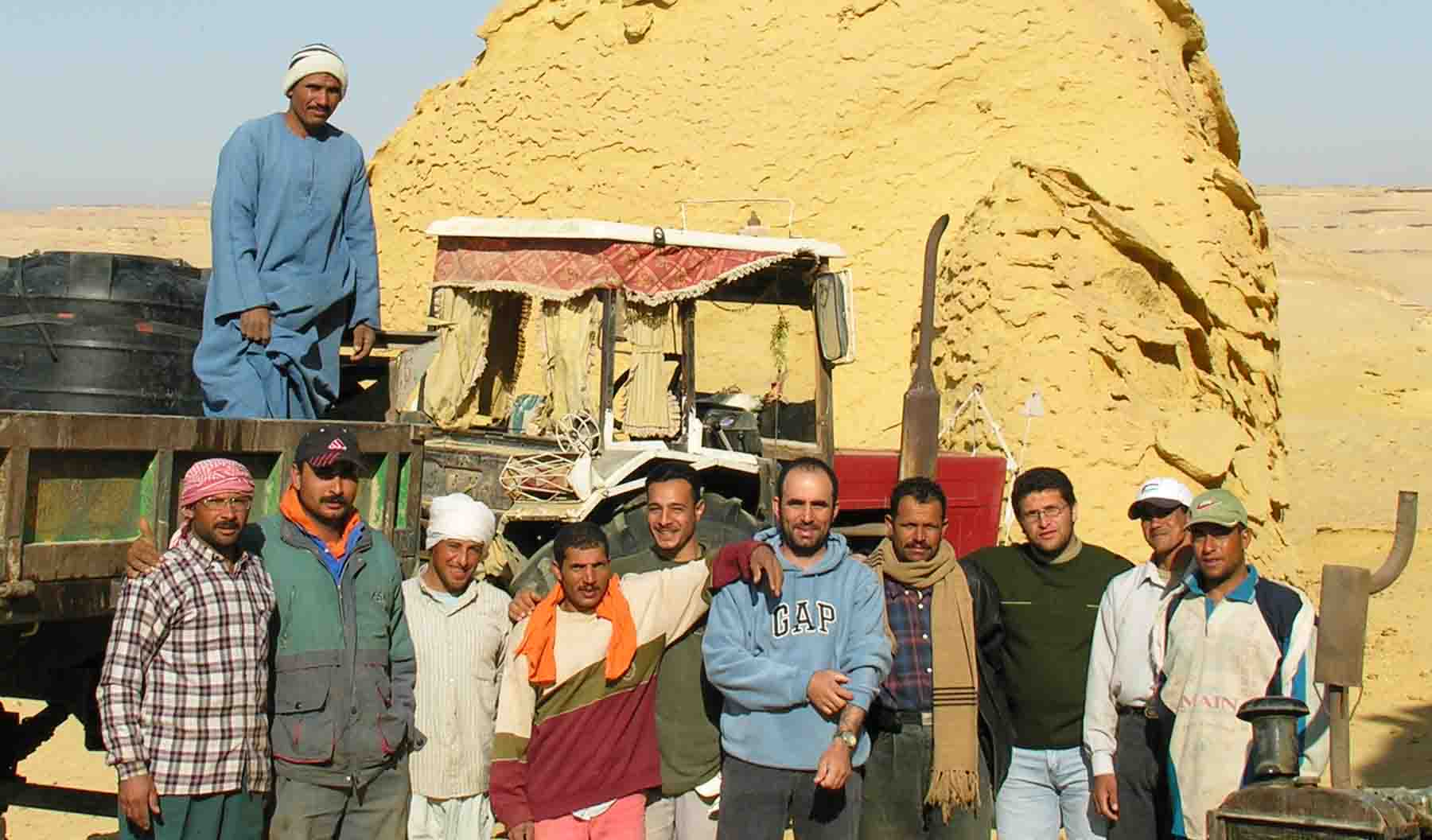Gingerich, P. D. 1977. A small collection of fossil vertebrates from the middle Eocene Kuldana and Kohat formations of Punjab (Pakistan). Contributions from the Museum of Paleontology, University of Michigan, 24: 190-203. PDF (Deep Blue) or Request PDF/reprint 35
Gingerich, P. D., D. E. Russell, D. Sigogneau-Russell, J.-L. Hartenberger, S. M. I. Shah, M. Hassan, K. D. Rose, and R. H. Ardrey. 1979. Reconnaissance survey and vertebrate paleontology of some Paleocene and Eocene formations in Pakistan. Contributions from the Museum of Paleontology, University of Michigan, 25: 105-116. PDF (Deep Blue) or Request PDF/reprint 61
Gingerich, P. D. and D. E. Russell. 1981. Pakicetus inachus, a new archaeocete (Mammalia, Cetacea) from the early-middle Eocene Kuldana Formation of Kohat (Pakistan). Contributions from the Museum of Paleontology, University of Michigan, 25: 235-246. PDF (Deep Blue) or Request PDF/reprint 110
Gingerich, P. D., N. A. Wells, D. E. Russell, and S. M. I. Shah. 1983. Origin of whales in epicontinental remnant seas: new evidence from the early Eocene of Pakistan. Science, 220: 403-406. PDF or Request PDF/reprint 133
Gingerich, P. D., B. H. Smith, and E. L. Simons. 1990. Hind limbs of Eocene Basilosaurus isis: evidence of feet in whales. Science, 249: 154-157. Online or Request PDF/reprint 215
Gingerich, P. D. and D. E. Russell. 1990. Dentition of early Eocene Pakicetus (Mammalia, Cetacea). Contributions from the Museum of Paleontology, University of Michigan, 28: 1-20. PDF (Deep Blue) or Request PDF/reprint 220
Gingerich, P. D. 1992. Marine mammals (Cetacea and Sirenia) from the Eocene of Gebel Mokattam and Fayum, Egypt: stratigraphy, age, and paleoenvironments. University of Michigan Papers on Paleontology, 30: 1-84. PDF (Deep Blue) or Request PDF/reprint 243
Gingerich, P. D., S. M. Raza, M. Arif, M. Anwar, and X. Zhou. 1993. Partial skeletons of Indocetus ramani (Mammalia, Cetacea) from the lower middle Eocene Domanda Shale in the Sulaiman Range of Pakistan. Contributions from the Museum of Paleontology, University of Michigan, 28: 393-416. PDF (Deep Blue) or Request PDF/reprint 264
Gingerich, P. D. 1994. The whales of Tethys. Natural History Magazine, New York, 103(4): 86-89. PDF or Request PDF/reprint 272
Gingerich, P. D., S. M. Raza, M. Arif, M. Anwar, and X. Zhou. 1994. New whale from the Eocene of Pakistan and the origin of cetacean swimming. Nature, 368: 844-847. Online or Request PDF/reprint 274
Gingerich, P. D., M. Arif, and W. C. Clyde. 1995. New archaeocetes (Mammalia, Cetacea) from the middle Eocene Domanda Formation of the Sulaiman Range, Punjab (Pakistan). Contributions from the Museum of Paleontology, University of Michigan, 29: 291-330. PDF (Deep Blue) or Request PDF/reprint 303
Gingerich, P. D., M. Arif, M. A. Bhatti, H. A. Raza, and S. M. Raza. 1995. Protosiren and Babiacetus (Mammalia, Sirenia and Cetacea) from the middle Eocene Drazinda Formation, Sulaiman Range, Punjab (Pakistan). Contributions from the Museum of Paleontology, University of Michigan, 29: 331-357. PDF (Deep Blue) or Request PDF/reprint 304
Gingerich, P. D. and M. D. Uhen. 1996. Ancalecetus simonsi, a new dorudontine archaeocete (Mammalia, Cetacea) from the early late Eocene of Wadi Hitan, Egypt. Contributions from the Museum of Paleontology, University of Michigan, 29: 359-401. PDF (Deep Blue) or Request PDF/reprint 312
Gingerich, P. D., M. Arif, M. A. Bhatti, M. Anwar, and W. J. Sanders. 1997. Basilosaurus drazindai and Basiloterus hussaini, new Archaeoceti (Mammalia, Cetacea) from the middle Eocene Drazinda Formation, with a revised interpretation of ages of whale-bearing strata in the Kirthar Group of the Sulaiman Range, Punjab (Pakistan). Contributions from the Museum of Paleontology, University of Michigan, 30: 55-81. PDF (Deep Blue) or Request PDF/reprint 322
Gingerich, P. D., M. Arif, M. A. Bhatti, and W. C. Clyde. 1998. Middle Eocene stratigraphy and marine mammals (Cetacea and Sirenia) of the Sulaiman Range, Pakistan. Bulletin of Carnegie Museum of Natural History, 34: 239-259. PDF or Request PDF/reprint 328
Gingerich, P. D. and M. D. Uhen. 1998. Likelihood estimation of the time of origin of Cetacea and the time of divergence of Cetacea and Artiodactyla. Palaeontologia Electronica, 1(2): 45 pp. [ http://palaeo-electronica.org/1998_2/ging_uhen/issue2.htm]. Online or Request PDF/reprint 331
Gingerich, P. D. 1998. Paleobiological perspectives on Mesonychia, Archaeoceti, and the origin of whales. In J. G. M. Thewissen (ed.), Emergence of Whales: Evolutionary Patterns in the Origin of Cetacea, Plenum Publishing Corporation, New York, pp. 423-449. Order book or PDF or Request PDF/reprint 341
Luo, Z. and P. D. Gingerich. 1999. Terrestrial Mesonychia to aquatic Cetacea: transformation of the basicranium and evolution of hearing in whales. University of Michigan Papers on Paleontology, 31: 1-98. PDF (Deep Blue, 6-Mb) or Request PDF/reprint 356
Zalmout, I. S., H. A. Mustafa, and P. D. Gingerich. 2000. Priabonian Basilosaurus isis (Cetacea) from the Wadi Esh-Shallala Formation: first marine mammal from the Eocene of Jordan. Journal of Vertebrate Paleontology, 20: 201-204. Online or Request PDF/reprint 356
Uhen, M. D. and P. D. Gingerich. 2001. New genus of dorudontine archaeocete (Cetacea) from the middle-to-late Eocene of South Carolina. Marine Mammal Science, 17: 1-34. Online or Request PDF/reprint 363
Gingerich, P. D., M. Haq, I. S. Zalmout, I. H. Khan, and M. S. Malkani. 2001. Origin of whales from early artiodactyls: hands and feet of Eocene Protocetidae from Pakistan. Science, 293: 2239-2242. Online or PDF or Request PDF/reprint 381
Gingerich, P. D., M. Haq, I. H. Khan, and I. S. Zalmout. 2001. Eocene stratigraphy and archaeocete whales (Mammalia, Cetacea) of Drug Lahar in the eastern Sulaiman Range, Balochistan (Pakistan). Contributions from the Museum of Paleontology, University of Michigan, 30: 269-319. PDF (Deep Blue) or Request PDF/reprint 384
Gingerich, P. D. 2002. Progress on the origin of whales. Geoscience News, University of Michigan, Winter 2002: 7-11. PDF or Request PDF/reprint 387
Gingerich, P. D.. 2002. Whales that walked. LSA Magazine, University of Michigan, 2002: 25-27. PDF or Request PDF/reprint 389
Dolson, J. C., A. E. Barkooky, F. Wehr, P. D. Gingerich, N. Prochazka, and M. V. Shann. 2002. The Eocene and Oligocene paleoecology and paleogeography of Whale Valley and the Fayoum basins: implications for hydrocarbon exploration in the Nile Delta and ecoturism in the greater Fayoum Basin. AAPG International Conference and Exhibition, Guidebook for Field Trip 7, Cairo, 1-79 pp. PDF
Gingerich, P. D. 2003. Land-to-sea transition of early whales: evolution of Eocene Archaeoceti (Cetacea) in relation to skeletal proportions and locomotion of living semiaquatic mammals. Paleobiology, 29: 429-454. Online or Request PDF/reprint 405
Gingerich, P. D. 2003. Stratigraphic and micropaleontologic constraints on the middle Eocene age of the mammal-bearing Kuldana Formation of Pakistan. Journal of Vertebrate Paleontology, 23: 643-651. Online or Request PDF/reprint 408
Gingerich, P. D. 2004. Whale evolution. McGraw-Hill Yearbook of Science and Technology, 2004: 376-379. PDF or Request PDF/reprint 413
Gingerich, P. D. 2005. Cetacea. In K. D. Rose and J. D. Archibald (eds.), Placental mammals: origin, timing, and relationships of the major extant clades, Johns Hopkins University Press, Baltimore, pp. 234-252. Order book, PDF or Request PDF/reprint 432
Gingerich, P. D., I. S. Zalmout, M. Haq, and M. A. Bhatti. 2005. Makaracetus bidens, a new protocetid archaeocete (Mammalia, Cetacea) from the early middle Eocene of Balochistan (Pakistan). Contributions from the Museum of Paleontology, University of Michigan, 31 (9): 197-210. PDF (Deep Blue) or Request PDF/reprint 439
Clementz, M. T., A. Goswami, P. D. Gingerich, and P. L. Koch. 2006. Isotopic records from early whales and sea cows: contrasting patterns of ecological transition. Journal of Vertebrate Paleontology, 26: 355-370. Online or Request PDF/reprint 446
Gingerich, P. D. 2007. Early evolution of whales: a century of research in Egypt. In J. G. Fleagle and Christopher C. Gilbert (eds.), Elwyn Simons: A Search for Origins, Springer, New York, pp. 107-124. PDF or Request PDF/reprint 471
Gingerich, P. D. 2007. Stromerius nidensis, new archaeocete (Mammalia, Cetacea) from the upper Eocene Qasr el-Sagha Formation, Fayum, Egypt. Contributions from the Museum of Paleontology, University of Michigan, 31: 363-378. PDF (Deep Blue) or Request PDF/reprint 472
Gingerich, P. D. 2008. Basilosaurus cetoides. Encyclopedia of Alabama, 1386: 1-3. Online or Request PDF/reprint 475
Gingerich, P. D., M. Haq, W. v. Koenigswald, W. J. Sanders, B. H. Smith, and I. S. Zalmout. 2009. New protocetid whale from the middle Eocene of Pakistan: birth on land, precocial development, and sexual dimorphism. PLoS ONE, 4 (e4366): 1-20. Online/PDF or Request PDF/reprint 487
Peters, S. E., M. S. Antar, I. S. Zalmout, and P. D. Gingerich. 2009. Sequence stratigraphic control on preservation of late Eocene whales and other vertebrates at Wadi al-Hitan, Egypt. Palaios, 24: 290-302. Online/PDF or Request PDF/reprint 488
Koenigswald, W. v. and P. D. Gingerich. 2009. Wale in der Wüste: Fossilbericht zum Weg der Wale vom Land ins Wasser. In N. Elsner, H.-J. Fritz, R. Gradstein, and J. Reidtner (eds.), Evolution: Zufall und Zwangsläufigkeit der Schöpfung, Wallstein Verlag, Göttingen, pp. 341-361. Request PDF/reprint 491
Gingerich, P. D. 2010. Cetacea. In L. Werdelin and W. J. Sanders (eds.), Cenozoic Mammals of Africa, University of California Press, Berkeley, pp. 873-899. Request PDF/reprint 502
Koenigswald, W. v. and P. D. Gingerich. 2010. Vom Land ins Meer-- Evolution der Wale. In G. Wefer and F. Schmieder (eds.), Expedition Erde: Wissenswertes und Spannendes aus den Geowissenschaften, MARUM Bibliothek: Verständliche Geowissenschaften, Bremen, pp. 284-291. Request PDF/reprint 519
Recent abstracts
Gingerich, P. D. 2006. Early whales Ichthyolestes and Pakicetus (Mammalia, Cetacea): terrestrial, aquatic, or both? Caveat emptor! (abstract). Journal of Vertebrate Paleontology, Abstracts of Papers, 26 (suppl. 3): 68. Abstract
Other
Gidley, J. W. 1913. A recently mounted Zeuglodon [Basilosaurus] skeleton in the United States National Museum. Proceedings of the U. S. National Museum, Washington, 44: 649-654.
Kellogg, R. 1936. A review of the Archaeoceti. Carnegie Institution of Washington Publications, 482: 1-366.
Uhen, M. D. 2004. Form, function, and anatomy of Dorudon atrox (Mammalia, Cetacea): an archaeocete from the middle to late Eocene of Egypt. University of Michigan Papers on Paleontology, 34: 1-222. PDF (Deep Blue: 66-Mb)
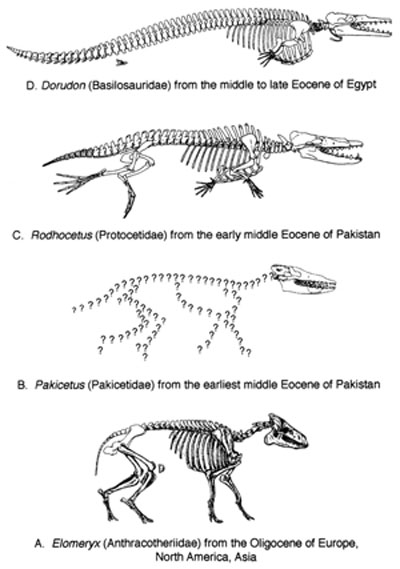 Figure 1.
Skeletons of the archaeocetes Dorudon atrox and Rodhocetus
balochistanensis compared to that of Elomeryx armatus,
which is here taken as a model for the extinct group of artiodactyls (Anthracotheriidae,
s.l.) that we now think may have given rise to archaic whales.
Pakicetus has a distinctive skull and lower jaw, but is not demonstrably
different from early protocetids postcranially. Note changes in
body proportions and elongation of feet for foot-powered swimming
in Rodhocetus, then later reduction of the hind limbs and feet
as the tail-powered swimming of modern cetaceans evolved in Dorudon.
Figure 1.
Skeletons of the archaeocetes Dorudon atrox and Rodhocetus
balochistanensis compared to that of Elomeryx armatus,
which is here taken as a model for the extinct group of artiodactyls (Anthracotheriidae,
s.l.) that we now think may have given rise to archaic whales.
Pakicetus has a distinctive skull and lower jaw, but is not demonstrably
different from early protocetids postcranially. Note changes in
body proportions and elongation of feet for foot-powered swimming
in Rodhocetus, then later reduction of the hind limbs and feet
as the tail-powered swimming of modern cetaceans evolved in Dorudon.